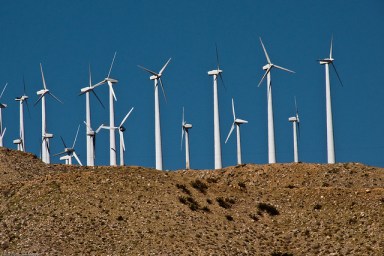California's 33% renewable energy goal by 2020 is not realistic

A law in April upped California's renewable energy goals by 2020 to 33% from 20%, a far more ambitious goal than any other state is attempting. But, while a renewable energy economy is a laudable goal, it seems doubtful that California will actually be able to achieve it. Or if it does, it will be through smoke and mirrors gambits.
PG&E is buying Renewable Energy Credits from wind farms in Canada to help them achieve their renewable goals in California even though that power will never be used within the state. But, an accounting transaction noting an investment in a foreign company does not cut emissions or provide renewable energy for Californians. Somewhat bizarrely, PG&E is just buying "green attributes" from the wind farms, not power and capacity, because they immediately sell the power and capacity back to them. Gosh, this seems almost as opaque as Collateralized Mortgage Obligations. Inquiring minds want to know how such transactions genuinely aid California moving to renewables.
If California genuinely wants to go to renewables, it must cease the tired and hypocritical game of piously banning coal plants within the state while still importing massive amounts of coal energy from Nevada, Arizona, and elsewhere. Not only does the coal pollute other states while allowing California to pretend it is using clean energy, sending the power along hundreds of miles of transmission lines wastes energy and puts extra load on the grid. Instead, a worthy goal would be to have California generate as much of its power internally, close to where it is used, and also to 'fess up to its dirty little coal addiction.
So then, let's just build lots of solar and wind farms and be done with it, right? Well, as of 2009, solar contributed 0.3% of California's power (that's not a misprint) while wind was 2.7%. Ramping that up to meet the 2020 goal is simply not feasible. It would require that tens of thousands of wind turbines be installed each year until then. Plus, the existing grid simply cannot handle that much intermittent power gracefully, if at all, and will need to be upgraded.
If you think tens of thousands of wind turbines plus several massive solar projects a year will be green-lighted without delay, think again. IHS Emerging Point Research predicts about 36% of contracted generation will fail to come online after 2015. The reasons include funding shortfalls, regulatory hurdles, environmental challenges, NIMBYs, and more.
Governor Jerry Brown is pushing hard for renewables but is definitely sending a mixed message when he simultaneously says the process will be democratic and not top-down, but then threatens to crush renewables opponents. Make up your mind, Mr. Governor, because those in smaller towns in desert areas are starting to feel steamrolled by the relentless push for fast-track development.
California's renewable energy goals may be politically popular, but it's difficult to see how they can be implemented by 2020.



